Fun and "N"tertainment
Feb 1 The saga continues, however slowly...
Last time I had the tractor running, I fiddled a bit with the PTO. This tractor has a rear hydraulic lift for the three-point hitch which is powered from the PTO shaft. I wasn't sure which direction the PTO shift lever needed to be in to engage the pump, so I brushed up on my research and applied that to this application. No action from the hydraulics in either position of the shift lever, not even a twitch from the lift. Back to the internet for more advice.
Several sites admonished that water in the differential case would cause the hydraulic pump to fail to build pressure, so the next trick was to check for condensation in the sump. After cracking open the drain plugs a few threads, a couple of ounces of clear water dripped out. "Great" I thought, problem solved, maybe. Opening the drain plug for the transmission resulted in some thick beige goo oozing out instead of water. I let this continue for a while, thinking that it was probably some homogenized water and gear lubricant that was hanging out in the bottom of the transmission. After a bit, I decided to have a look inisde the top of the transmission, as the filler plug is nice and big, and looks directly down the side of the gearbox. Well, what I saw inside was more of the white stuff, lots more, the whole transmission (and presumably the differential) were filled with the stuff, and it didn't look like it was supposed to be in there.
More research. The "tips and tricks" mentioned that if the gear oil looked "milky", that it had water in it and needed to be changed. To me, something that looked "milky" was supposed to have a kind of white translucent sheen to it that isn't natural, not something that was pure white, or very close to it.
Now, at this point this tractor is still experimental, and I wasn't about to go out and plop down $60-75 or more on 5 gallons of 90 weight gear oil. If the lube needed to be changed, then that's what I'd do, change it back into pure oil. Separating oil from water is not all that difficult.
First, I needed to drain the oil out. All of the web sites cautioned that I needed to be ready to deal with 5 gallons of oil that was going to come cascading out when I pulled the drain plug. My drain pans hold a little over a gallon, and the tractor isn't tall enough to get a 5 gallon bucket underneath the transmission, so I was going to have to pull the plug, partially fill the drain pan, then put the plug back in and stop the flow before the pan overflowed. It wasn't all that difficult, actually it was a lot easier than changing the oil in my small tractor where there is no room to get your hand where it needs to be, and then get burned by hot oil and drop the plug into the funnel feeding the pan, causing it to overflow (this seems to always happen when changing the oil on that tractor).
Anyhow, I got a couple of panfuls of lubricant out and poured it into clean used motor oil containers. Here's what the pan looked like afterwards:
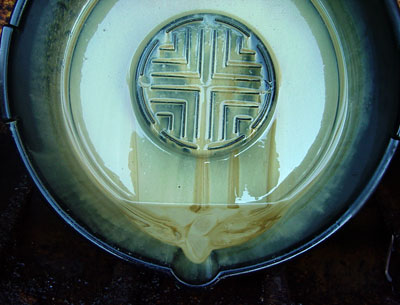
As you can see, it really doesn't resemble oil at all. Actually it looks a whole lot like Latte coffee, which is a bit confusing, because I am kind of attracted to it because of this. Whipped cream on your drink?
My thinking was that in order to get rid of the emulsified water in the oil, all I needed to do was heat the oil above the boiling temperature of water. The water would boil off and evaporate, while the oil would remain unchanged. So that's what I'm doing, half a gallon at a time, using a single burner electric hot plate to supply the heat.
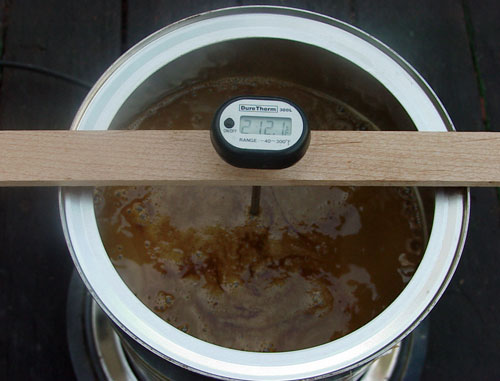
Because I don't need the oil to be much hotter than 212°F, I'm using a variable transformer to limit the amount of heat to about 220°. I don't know how much heat the oil can take before it changes or breaks down, but I do know that temperatures much higher make the turbulence in the thinned out oil very active, and it tends to splash out of the coffee can that I'm using as a cauldron. A small digital thermometer helps me keep tabs on the temp and adjust the transformer for the correct amount of heat.
This morning, I improved the process by adding a surrounding ring of metal to shield the can and keep in some of the heat. The thermometer is now poking in through the plywood lid.
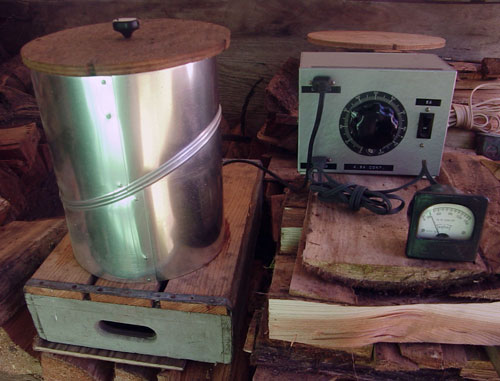
OK, so what is this getting me? Well, after six hours at 220°F, all the water had boiled off and the murky appearance had cleared. There was still a tiny amount of bubbles coming up from the oil, but I had decided that the process was complete. This is the end result:
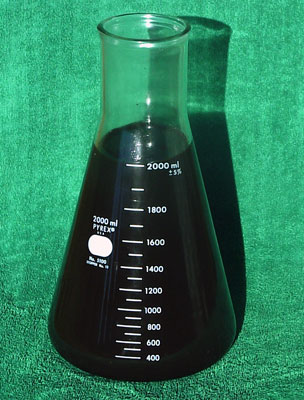
There were a few drops of liquid water at the bottom of the can, and a tablespoon or so of some sludge-like substance that might be rust or something, but the bulk of the material was completely clarified. I easily held back the water and sludge while pouring the contents of the can into the beaker.
The process continues, one coffee can full at a time. The resulting clear oil is being put into a clean 5-gallon plastic pail, and once I let the tractor's gearbox and differential drip out for a few days, I'll put the lubricant back in and try the hydraulic pump again. Of course, there are still many reasons why the pump might not work correctly, but water in the oil won't be one of them.
Feb 4 Last week my new fuel tank was delivered, and I went into town yesterday to pick it up. The previous owner said that the old tank most likely leaked, and considering the amount of rust and dirt of all sorts that it probably contained, a ninety-nine dollar fleaBay replacement seemed like a good value. Attempting to solder up, epoxy, or otherwise seal up the old tank just wasn't worth the effort at this price. It''s made in India (one step up from China), but then what is actually made in this country anymore?
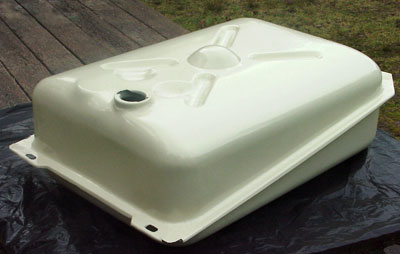
The hood and grille have to come off to install this, which means that the old, rusty loader has to come off as well. It might be time to put up a Craigslist advert and see if I can find a local buyer who wants it for parts.
The box that the tank was delivered in had a catalog and a 2013 tractor calendar included. The catalog showed photos of Ford N series tractors fitted with brand-new, modern front loader attachments, so it's obviously possible to put something much less clunky and more functional in place of the ratty rust pile that's on it now. All it takes is a loader bucket full of money...
Feb 13 Well, I've finally shut down the oil-refinery-on-a-hot-plate, as the last of the gear oil has been clarified. Doing a half gallon at a time, you'd expect that it would take ten sessions and you'd be done, but the lower the oil came from the gear case the more dissolved water it contained, and the thicker and slimier it became. The last bit out of the very bottom had the consistency of gruel, it came out in gobs, rather than as a stream of thick liquid. This stuff took a lot longer, and a lot more cooking to evaporate out the water and settle the solids.
I had been thinking during this process that there was probably a thick layer of slime in the bottom of the gear case that wasn't coming out of the drain plug. The hydraulic pump, which was the whole reason for draining the fluid, takes it's input from the bottom of the gear sump. That means that it was subject to the very worst of the muck. I had pretty much decided that I should drop the pump out the bottom of the gear case and clean up the pump housing, and get rid of the muck before trying to refill the tractor and run it. When I removed the right side inspection cover, I really couldn't see very much, but what I could see looked as bad as I had imagined.
When I moved the three-point hydraulic control, it felt like it was binding, and watching it through the inspection plate made it look like it was not moving anything in the bottom of the sump, where the pump lives. It turns out that it's possible to look upwards into the drain plug hole, which is a nice 2" diameter, and see the control valve for the hydraulic cylinder, and see the wishbone-shaped control yoke coming down from the hand control under the seat. Neither of these looked like they were moving, and although I wasn't absolutely sure how they were supposed to move, I was sure that they weren't doing it in proper response to the hand control.
I got online and ordered up a gasket kit for the hydraulic system. It wasn't very expensive, but now I was convinced that I had to drop the pump and see what was going on.
After getting the control yoke off (not much fun, jambing my hands in the inspection hole), and removing the power take off drive shaft, I removed the eleven 7/16" bolts that held the pump to the bottom of the gear case. A little persuasion with a BFS (Big Freakin' Screwdriver), the pump dropped onto the boards I had set up to support it. It was a little tricky to maneuver back and out of the gear case, but it didn't hang up on anything. My suspicions were confirmed, it had about an inch and a half of nasty oil and water slime covering it and sitting at the bottom of the casting. The control valve was not moving, and didn't yield to fairly firm attempts to move it by hand, so I decided to let that ride until I had cleaned everything off and could get a better look at what was underneath the film of goo.
It was a pleasant surprise to find that the control valve wasn''t in a blind hole, but a tunnel had been cast into the pump body so I could use a rod to drive the control valve spool out of the body from the other side. It didn't take very much hammering (tapping, really, I was being very careful) before it popped out. It looked fine, but had a tiny amount of surface rust in two places. Once this was cleaned off and the rest of the spool buffed to a shine, it went back into the now cleaned out valve body and fit like it was machined to glide in an out on a film of oil.
At any rate, here's the finished product, ready to put back into the tractor.
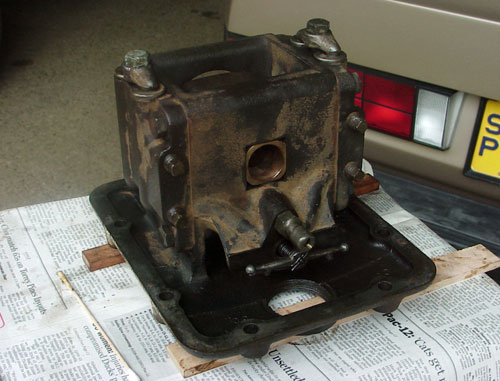
The mating surfaces have been cleaned of old gasket material, and while it would have been a nice touch to completely disassemble the pump and throughly clean all the parts individually, that's not in the cards right now.
More tomorrow, I gotta date with a hot shower to get this grease out of my pores.
Feb 14 Yesterday, it looked like I might be over the greasy part of this job. The last of the gear oil was off the burner and in the saved bucket, I had drained the last drops out of the three motor oil jugs that I had been using to transport and store the nasty used oil, I had drained out and cleaned the three pie plates, two oil drain pans and several soup cans that were used to catch, portion and store the oil during the process, and all of the oily rags, wet newspapers, etc were disposed of.
As part of the reassembly process, I had run a 7/16x14 thread cutting die over the two dozen bolts that I had taken out, and wire brushed the metal filings out of the threads. The PTO shaft and bearing bushing were wiped down and the splines cleaned out. Everything seemed ready for the arrival of the gasket set I had ordered. It looked like things would be clean and clear sailing from here on.
Then I remembered that I needed to scrape any gasket material off of the tractor surfaces where I had removed the pump, inspection plate and PTO. Thinking that it would take only a few minutes, I went out to the shed with a razor knife blade, a rag and my drop light. After plugging in the light, I got my first good look inside the differential housing where the PTO had been removed. Oh joy! There were loads more huge blobs of yucky slime covering the bottom of the housing and every horizontal surface inside the differential. I began lifting the gunk out with a putty knife. In some places, it was an inch thick.
After a while, the putty knife had reached all it could, and I began having to put my gloved hand inside the PTO opening to reach more. Soon I was in up past my wrist. Still there was more to remove, farther in. You can see where this is going. The putty knife proved useless for reaching into some of the less accessible areas and contoured spaces of the differential housing, so eventually I resorted to just using my hand to scoop up fistfuls of muck and draw it out of the casing. In the end, I was going in all the way to my elbow to get the front of the cast iron housing and in front of the ring gear. I found out pretty fast that there are sharp things inside there when my glove was lacerated and I got a prick from some left-behind shard of casting that wasn't ground off in manufacturing.
In all, I ended up with almost three cups of goo, and there is still more where I can't reach it. I'm thinking I'll fabricate some kind of small rake device to reach around the differential gears and at least grab the biggest curds of grease.
When it's all over, there will still be areas that haven't been throughly cleaned of old lubricant and emulsified water. I figure that once the tractor is working and has heated up and circulated the clean oil in all the places I can't reach, I'll end up having to drain the sumps, remove the gear oil and then go through the heating and clarification process at least once again. This is yet another reason to reuse the old, cleaned up oil. Putting in new oil several times to flush out the transmission, differential and hydraulic pump would be very, very expensive. The method of getting as much dirt as I can and depending on the remainder coming out in the future is a poor substitute for tearing the entire machine down to tiny pieces and cleaning each part individually with solvent. that process is called "restoration" and it''s a slippery slope towards compulsive tractor collecting and hoarding. I don''t want to go there.
Original material ©1996-2025 Mr. Sharkey | All rights reserved
